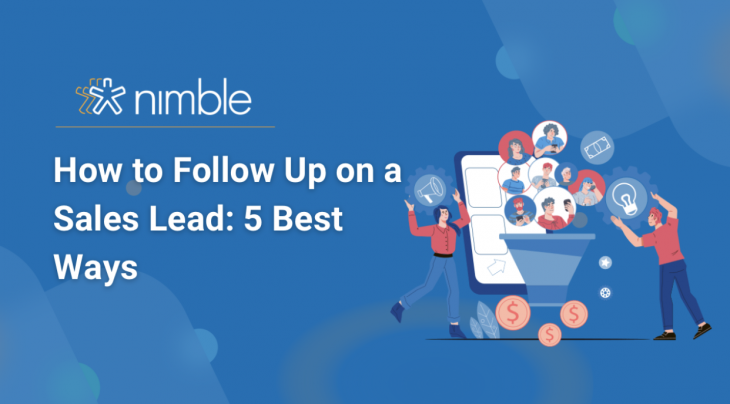Securing a sales lead is just the first step; the real challenge lies in nurturing and converting those leads into satisfied customers. In this blog, we’ll delve into the art of following up on sales leads and explore five best practices to enhance your lead conversion rates. By mastering these strategies, you’ll not only optimize your sales process but also build lasting relationships with potential clients. Let’s dive in and discover the keys to successful lead follow-up.
Nurturing Opportunities: Strategies for Following Up on a Sales Lead Effectively
Before we jump into the intricacies of lead follow-up, it’s crucial to grasp the concept of sales leads. A sales lead is a potential customer who has expressed interest in your product or service, either by responding to marketing efforts, filling out a form, or engaging with your company in some way. Leads are the lifeblood of any sales operation, representing opportunities for growth and revenue.
Leads can be categorized into different types, such as warm leads, which indicate a higher level of interest, and cold leads, where the prospect’s interest might be more ambiguous. Understanding the nuances of your leads allows you to tailor your follow-up approach based on their level of engagement and likelihood to convert. By segmenting and prioritizing your leads, you can allocate resources more efficiently and increase your chances of turning prospects into customers.
Why Perform a Lead Follow-Up?
The question of why lead follow-up is essential boils down to maximizing the potential value of each prospect. A sales lead is not a guaranteed sale; it’s an opportunity that requires careful cultivation. Following up on leads is a proactive strategy to nurture relationships, address concerns, and guide potential customers through the sales funnel.
Effective lead follow-up serves several purposes:
- Builds Trust: Regular communication with leads demonstrates your commitment to meeting their needs and addressing their concerns. This builds trust and establishes your credibility as a reliable business partner.
- Addresses Concerns: Prospects may have questions or reservations that hinder their decision-making process. Timely follow-up allows you to address these concerns, provide additional information, and alleviate any hesitations they may have.
- Keep Your Brand Top of Mind: In a competitive market, staying top of mind is crucial. Regular follow-ups ensure that your brand remains in the forefront of a prospect’s thoughts, increasing the likelihood that they will choose your product or service when the time comes to make a decision.
- Shortens the Sales Cycle: Actively engaging with leads accelerates the sales cycle by guiding them through the decision-making process. It prevents leads from going cold and ensures that momentum is maintained until a successful conversion occurs.
By understanding the importance of lead follow-up and approaching it strategically, you position yourself to capitalize on the full potential of your sales opportunities. In the following sections, we’ll delve into five best practices for effective lead follow-up, providing actionable insights to elevate your sales game.
5 Best Ways to Follow Up on a Sales Lead
- Personalized Follow-Up Emails: Craft emails that go beyond generic templates by incorporating specific details discussed during interactions. For example, if a lead expressed interest in cost-saving features during a demo, the follow-up email should delve into how these features can directly impact their bottom line. Personalization demonstrates attentiveness, reinforcing the idea that your product or service aligns with their unique need
- Leverage Social Media Engagement: Beyond a mere connection request, actively engage with leads on social media platforms. Comment on their posts, share relevant content, or initiate conversations related to their industry challenges. This approach not only keeps your brand visible but also positions you as a valuable resource, fostering a relationship that extends beyond the formal sales process.
- Timely Phone Calls: Timing is crucial when making follow-up calls. Consider reaching out shortly after a lead has interacted with your content or attended an event. During the call, focus on addressing any questions or concerns they may have, emphasizing a commitment to providing real-time support. This approach not only showcases your dedication but also capitalizes on the momentum of their recent engagement.
- Automated Following Up on a Sales Lead: Develop a well-thought-out series of automated emails that gradually nurture leads through the sales funnel. Tailor the content to align with their progression, offering valuable insights, case studies, or exclusive content at each stage. Automation ensures consistent engagement without overwhelming the lead, guiding them towards a decision while maintaining a personalized touch.
- Offer Strategic Incentives: Instead of generic discounts, tailor incentives based on the lead’s behavior and preferences. For example, if they’ve shown interest in a particular product feature, provide a time-limited offer related to that feature. This not only creates a sense of exclusivity but also demonstrates a keen understanding of their specific needs, making the incentive more compelling and likely to drive conversion.
From Leads to Loyalty: Automated Sales Follow-Up Guide
To establish automated follow-ups on a sales lead, begin by integrating a robust CRM system. For example, you can use popular CRM platforms to create workflow rules that automatically trigger follow-up emails based on lead activities. Segment your leads based on criteria such as industry, engagement level, or geographical location. For instance, if a lead has visited specific product pages on your website, automate a follow-up email highlighting additional features or offering a personalized demo.
Crafting compelling content is crucial. Use marketing automation tools to create dynamic content that adapts based on the lead’s preferences. If a lead has shown interest in specific solutions, automate an email series focusing on the corresponding benefits of your product or service.
Utilize email marketing platforms to set up drip campaigns. Send an initial email introducing your product, followed by a series of emails highlighting case studies or success stories. Personalize each email with the lead’s generic information to enhance engagement.
Regularly analyze the performance of your automated campaigns using analytics tools. Track open rates, click-through rates, and conversion rates. If a particular email in your sequence is underperforming, use A/B testing to experiment with different subject lines or content formats.
By leveraging these strategies and tools, you can establish an efficient automated follow-up system that maximizes engagement and increases the chances of converting sales leads into loyal customers.
Tools to Follow-Up on a Sales Lead
Employing the right tools is essential for effectively following up on sales leads and nurturing prospects through the conversion process. Customer Relationship Management (CRM) systems play a pivotal role by providing a centralized platform to manage leads, automate follow-up sequences, and track interactions.
Email marketing platforms such as Mailchimp or Constant Contact are invaluable for creating and deploying targeted email campaigns, allowing for personalized communication and drip campaigns. Social media management tools, including Hootsuite or Buffer, enable businesses to monitor and engage with leads across various platforms, fostering a more interactive and dynamic relationship. Incorporating analytics tools, such as Google Analytics or Mixpanel, helps in assessing the performance of follow-up strategies, enabling businesses to refine their approaches based on valuable insights. Integrating these tools into a cohesive follow-up strategy empowers sales teams to efficiently manage and convert leads into loyal customers.
How To Set Up Lead Follow-Ups in Nimble
Optimize your lead follow-up strategy in Nimble by harnessing the power of workflows and automation. Break down your process into defined stages and leverage Nimble’s workflow feature to automate tasks and trigger reminders based on specific actions. Configure tailored task and reminder settings to ensure timely follow-ups, and seamlessly integrate call and meeting events for a comprehensive view of your interactions.
Examples of Follow- Up on a Sales Lead
- Personalized Email Sequences: Craft a series of emails tailored to the lead’s preferences and interactions. For instance, after a product demo, follow up with an email highlighting specific features discussed and offering additional resources for a deeper understanding.
- Social Media Engagement: Actively engage with leads on platforms like LinkedIn or Twitter. Comment on their posts, share relevant content, or initiate conversations related to their industry challenges. This not only keeps your brand visible but also builds a relationship beyond the formal sales process.
- Timely Phone Calls: Make strategic follow-up calls based on lead activities. For instance, if a lead has downloaded a whitepaper, call to discuss key takeaways and address any questions they may have.
- Webinar Invitations: If a lead has shown interest in a particular topic, invite them to relevant webinars or virtual events. This provides additional value and positions your brand as a knowledgeable resource in their field.
- Exclusive Promotions: Offer personalized incentives based on the lead’s preferences. For example, if they’ve expressed interest in a specific product line, provide an exclusive discount or early access to new releases.
These examples illustrate the importance of varied and personalized follow-up approaches, showcasing a commitment to understanding the lead’s needs and providing value throughout the sales process.
Nimble: Your Lead Follow Up Tool
Nimble makes follow-up techniques in sales easier with a smart and personalized follow-up approach. Instead of using generic messages, Nimble quickly connects with leads using tools like web forms and automations, capturing important info to understand their needs. Automations simplify follow-ups by creating tasks and reminders customized for each lead.
Nimble goes beyond the usual methods by using social media like LinkedIn and Twitter to connect with leads authentically. This approach turns lead follow-ups into strategic efforts that focus on building real relationships in the digital world. Try Nimble to upgrade your lead generation, adding a personal touch to each interaction for lasting success.
Wrapping Up Success with Mastering Lead Follow-Up
Highlighting the critical role of effective lead management in the dynamic realm of sales, the post underscores the importance of successfully following up on leads as the key to transforming prospects into satisfied customers. It stresses the need to understand different types of leads and strategically follow up to build trust, address concerns, and keep the brand top of mind. The article explores five best practices for lead follow-up, including crafting personalized emails, engaging on social media, making timely phone calls, implementing automated campaigns, and offering strategic incentives. It also provides insights on leveraging tools such as CRM systems, email marketing platforms, and analytics tools to enhance the follow-up process.



